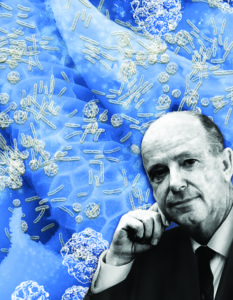We count on livestock for food and fiber, but raising these animals also produces an atmosphere-warming gas: methane. Those emissions mainly come from gut microbes — the bacteria and archaea breaking down plant matter. So since 2010, the JGI has supported researchers studying those microbial methane-makers. Eventually, that could help us dial back their emissions, while still producing things like meat, milk, and wool. Hear more from JGI collaborators Sinead Leahy (New Zealand Agricultural Greenhouse Gas Research Centre) and Bill Kelly (AgResearch). Find show notes here.
Episode Transcript:
Allison: And now, a JGIota — a snippet about JGI-related research, tools, people, discoveries and more. I’m Allison Joy, your host for this Iota.
For 25 years, the JGI has been supporting genomics research – so as part of this year’s 25th anniversary celebration, we’re taking a look back at the many fields of science where the JGI has enabled great research. And today, we’re focusing on a literal field – think, one that’s full of livestock.
Because behind every field of cows, or sheep, or goats – ok, probably enough farm sounds – there’s another herd that’s hard at work.
A herd of gut microbes inside the livestock. These animals do most of their digestion in one large stomach compartment — their rumen. So the microbes we’re talking about are rumen microbes.
These rumen microbes are the bacteria and archaea that pull nutrients out of grass, and allow livestock to produce meat and milk.
However, they’re also the microbes that create large amounts of the greenhouse gas methane. Methane drives climate change, and actually warms our atmosphere much more quickly than carbon dioxide.
And about a third of all the methane emissions that we make as humans actually come from livestock and their methane-making microbes. So we’d like to understand those microbes better. Ideally, that could open up avenues to minimize that methane, while raising livestock for milk, meat, and wool.

JGI’s Rekha Seshadri and AgResearch’s Sinead Leahy work on the Hungate 1000 manuscript published in 2018.
And since 2010, the JGI has partnered with researchers around the world to map out genomes of rumen microbes. Sinead Leahy is one of those researchers, with the New Zealand Agricultural Greenhouse Gas Research Centre. She says that in the beginning of this partnership, we knew very little about the many microbes involved in making methane. [Learn more in this complementary blog.]
Sinead Leahy: Tor example, in 2011, there were only 15 rumen microbe genome sequences available to us.
Allison: In the last twelve years, the JGI has supported a number of different projects on rumen microbes through the Community Science Program (2010)(2012)(2017). In 2014, researchers compared sheep that generated different levels of methane. And they found that microbial gene regulation seemed to affect methane production.
And in 2018, Sinead joined Rekha Seshadri, from the JGI. They co-led another project that boosted that count of rumen microbe genome sequences — by a grand total of 410 genomes!
Sinead Leahy: So we generated, you know, a really useful microbial resource of both cultures and genome sequences that were representative of the cultures that existed at the time. We took cultures from 15 different lifestyle species and from 21 different countries.
Allison: That included cows, goats, and sheep — all of the animals we typically think of when we think of livestock. But other animals depend on rumen microbes for digestion too. So the team also widened their lens to look at more animals — like moose! llamas! Yak! bison, and even camels. They called this entire effort the Hungate 1000. Here’s Bill Kelly, a collaborator at Ag Research, on where that name came from.

Robert Hungate, the microbiologist who invented the widely-used method of cultivating strictly anaerobic bacteria that now bears his name. (Image of Robert Hungate from Special Collections, University of California Library, Davis; composite image by Rekha Seshadri, JGI; and Zosia Rostomian/Berkeley Lab).
Bill Kelly: The title of the project, the Hungate 1000, is a tribute to Robert Hungate who was the pioneer of the techniques for the cultivation of anaerobic microbes.
Allison: Starting in the 1930’s, Hungate studied gut microbes in species like cows and termites. And just as he’d worked to understand how they break down plant material then — Sinead, Bill, and their team have continued to build on that research today.
Sinead Leahy: We used a variety of different analyses in conjunction with the JGI to help provide new insight into how those microbial processes occur in the rumen.
Bill Kelly: And, you know, now that we have this awesome collection of genome sequences and the cultures that underpin them, it opens the possibility of doing a range of other interesting pieces of work to see how, what these organisms are doing and how they interact with their animal host.
Allison: Like any broad genomic catalog, the Hungate 1000 provides a starting point for more targeted studies down the line. It opens up the possibility of experiments on specific microbes, or many microbes at once – to find out who’s making the most methane, and how to minimize that.
Before we go, here’s one neat follow up study. Recently, this team of researchers used genomic sequences — from that Hungate 1000 collection — to zoom in on the methane production pipeline in sheep rumen. This is a complicated process. But it’s known that methane-making microbes rely on one ingredient to do a lot of their work. That ingredient is hydrogen gas.
So, using Hungate 1000 genome sequences, they took a look at all the microbes making hydrogen gas. So — better-understand the microbes enabling the methane-makers. They found many different microbes doing this — Clostridia species stood out. But they also found other microbes that removed hydrogen gas from the rumen. So, there are potentially different knobs to turn, to change the amount of material that methane-making microbes have access to.
And those insights could one day lead to more tweaks in breeding, or feeding, that drop methane emissions in many kinds of livestock.
OK, so that’s a wrap on our gathering of gut microbes. But you can keep the party going, if you like — all of the data from this project is available on the JGI’s IMG/M data portal. We’ll link to it in the show notes. Rekha says you can even compare your favorite genomes with that Hungate collection.
And you can learn more about the JGI’s other work on our website and Youtube channel. We’ve also got a number of highlights on our website about other discoveries the JGI has made in its 25-year tenure. There’s a link in the show notes!
This episode was written and produced by Menaka Wilhelm, and hosted by me, Allison Joy! I had production help from Massie Ballon and Ashleigh Papp. Special Thanks to AgResearch in New Zealand, for recording these interviews, Graeme Attwood, and JGI’s own Rekha Seshadri.
If you liked this episode, help someone else find it! Tell them about it, send a link over, or leave us a review wherever you’re listening to the show.
The Hungate1000 project was funded by the New Zealand Government in support of the Global Research Alliance on Agricultural Greenhouse Gases. The genome sequencing and analysis component of the project was supported by the US Department of Energy Joint Genome Institute (JGI) through their Community Science Program.
Genome Insider is a production of the Joint Genome Institute, a user facility of the US Department of Energy Office of Science located at Lawrence Berkeley National Lab in Berkeley, California.
Thanks for tuning in – until next time!
Show Notes
- JGI@25 Stories
- The JGI’s IMG/M data portal
- News Release: A Reference Catalog for the Rumen Microbiome
- Video: More on the AgResearch DNA sequencing of rumen microbes
- Our contact info:
- Twitter: @JGI
- Email: jgi-comms at lbl dot gov
Genome Insider is a production of the Joint Genome Institute.